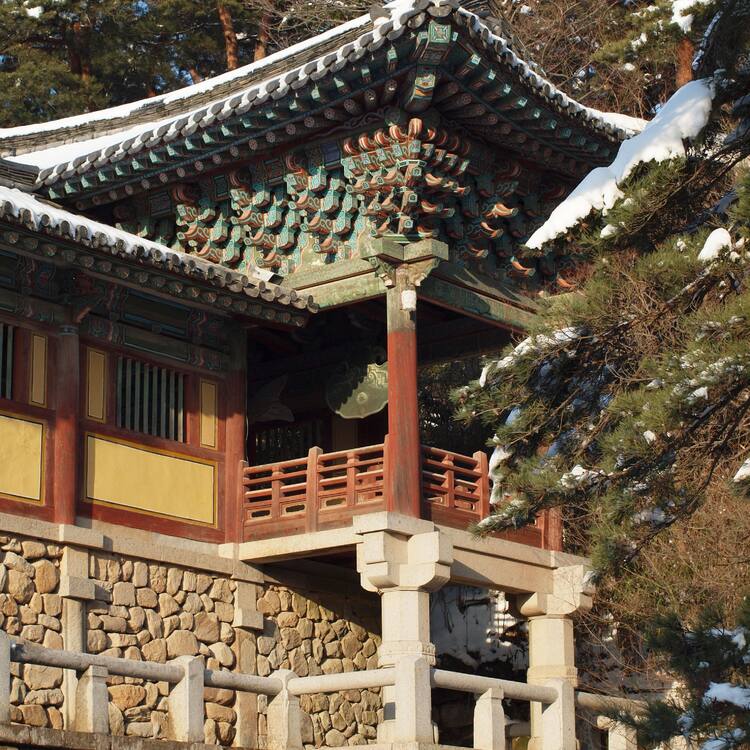Seokguram Grotto and Bulguksa Temple
Seokguram Grotto and Bulguksa Temple
Established in the 8th century on the slopes of Mount Toham, the Seokguram Grotto contains a monumental statue of the Buddha looking at the sea in the bhumisparsha mudra position. With the surrounding portrayals of gods, Bodhisattvas and disciples, all realistically and delicately sculpted in high and low relief, it is considered a masterpiece of Buddhist art in the Far East. The Temple of Bulguksa (built in 774) and the Seokguram Grotto form a religious architectural complex of exceptional significance.
Description is available under license CC-BY-SA IGO 3.0
Grotte de Seokguram et temple Bulguksa
Aménagée au VIIIe siècle sur les pentes du mont Toham, la grotte de Seokguram renferme une statue monumentale de Bouddha regardant la mer dans la position bhumisparsha mudra . Avec les représentations de divinités, de bodhisattva et de disciples qui l'entourent, sculptées en hauts reliefs et bas reliefs avec délicatesse et réalisme, c'est un chef-d'œuvre de l'art bouddhique d'Extrême-Orient. Le temple de Bulguksa, construit en 774, forme avec la grotte un ensemble d'architecture religieuse d'une valeur exceptionnelle.
Description is available under license CC-BY-SA IGO 3.0
مغارة سوكغول آم ومعبد بولغوكسا
تحوي مغارة سوكغول آم التي تم تأهيلها في القرن الثامن على منحدرات جبل توهام تمثالاً ضخماً للبوذا متأملاً البحر بوضعية. اما المنحوتات والنقوش الدقيقة والواقعية التي تمثل الآلهة والبوديتسافا والتلاميذ المحيطين به، فتحوّل المغارة الى تحفة من الفن البوذي الخاص بالشرق الأقصى. ويشكل معبد بولغوكسا الذي شيد عام 477 مع المغارة مجموعة هندسية دينية تتسم بقيمة لا نظير لها.
source: UNESCO/CPE
Description is available under license CC-BY-SA IGO 3.0
石窟庵和佛国寺
石窟庵建于公元8世纪,位于吐含山的斜坡上,石窟庵内有一尊纪念佛像,该佛像以普密斯帕莎穆德拉姿势面朝着大海。佛像周围有各种神仙、菩萨和信徒的雕像,这些雕像惟妙惟肖,工艺细腻,采用了深浅浮雕的方式,堪称远东地区佛教艺术杰作。佛国寺(建于公元774年)和石窟庵一起构成了一处具有重大意义的宗教建筑群。
source: UNESCO/CPE
Description is available under license CC-BY-SA IGO 3.0
Пещерный храм Соккурам и храмовый комплекс Пульгукса
Основанный в VIII в. на склонах горы Тхохамсан пещерный храм Соккурам содержит монументальную статую Будды, сидящего в позе лотоса и смотрящего в сторону моря. Вместе с окружающими его изображениями божеств, Бодхисаттв и учеников, реалистично и бережно выполненными в горельефах и барельефах, этот храм признается шедевром буддийского искусства Дальнего Востока. Храм Пульгукса (построен в 774 г.) вместе с пещерным храмом Соккурам образуют религиозный архитектурный комплекс исключительного значения.
source: UNESCO/CPE
Description is available under license CC-BY-SA IGO 3.0
Gruta de Seokguram y templo de Bulguksa
Situada en la ladera del monte T’oham, la gruta de Seokguram fue acondicionada en el siglo VIII para albergar una monumental estatua de Buda en la posición bhumisparsha mudra. Rodeada de imágenes de divinidades, bodhisatvas y discípulos, esculpidas en altorrelieve y bajorrelieve con gran delicadeza y realismo, esta estatua es una obra maestra del arte budista del Lejano Oriente. El templo de Bulguksa, construido en 774, forma con la gruta un conjunto arquitectónico religioso de valor excepcional.
source: UNESCO/CPE
Description is available under license CC-BY-SA IGO 3.0
石窟庵と仏国寺
慶尚北道慶州市にある。創建は8世紀半ばで、仏国寺の現在の建物は再建されたもの。伽藍配置は仏教浄土を表すとされ、境内には国宝の白雲橋、青雲橋、多宝塔、釈迦塔などの石造物が多くある。吐含山の山上の石窟庵は、石窟の円形空間に阿弥陀如来坐像を主仏として配している。source: NFUAJ
Seokguram grot en tempel van Bulguksa
De Seokguram grot werd in de 8e eeuw uitgehouwen in de berg Toham. De grot bevat een monumentaal standbeeld van de Boeddha die naar de zee kijkt in de 'bhumisparsha mudra' positie. Met de omringende afbeeldingen van goden, bodhisattva’s en discipelen – realistische en zorgvuldig gebeeldhouwd in hoog en laag reliëf – wordt het beschouwd als een meesterwerk van boeddhistische kunst in het Verre Oosten. De tempel van Bulguksa – gebouwd in 774 – omvat een reeks houten gebouwen op verhoogde stenen terrassen. Samen met de Seokguram grot vormt het een religieus architectonisch complex van uitzonderlijke betekenis.
Source: unesco.nl
Outstanding Universal Value
Brief synthesis
Established in the 8th century under the Silla Dynasty, on the slopes of Mount Tohamsan, Seokguram Grotto and Bulguksa Temple form a religious architectural complex of exceptional significance. Prime Minister Kim Dae-seong initiated and supervised the construction of the temple and the grotto, the former built in memory of his parents in his present life and the latter in memory of his parents from a previous life.
Seokguram is an artificial grotto constructed of granite that comprises an antechamber, a corridor and a main rotunda. It enshrines a monumental statue of the Sakyamuni Buddha looking out to sea with his left hand in dhyana mudra, the mudra of concentration, and his right hand in bhumisparsa mudra, the earth-touching mudra position. Together with the portrayals of devas, bodhisattvas and disciples, sculpted in high and low relief on the surrounding walls, the statues are considered to be a masterpiece of East Asian Buddhist art. The domed ceiling of the rotunda and the entrance corridor employed an innovative construction technique that involved the use of more than 360 stone slabs.
Bulguksa is a Buddhist temple complex that comprises a series of wooden buildings on raised stone terraces. The grounds of Bulguksa are divided into three areas – Birojeon (the Vairocana Buddha Hall), Daeungjeon (the Hall of Great Enlightenment) and Geungnakjeon (the Hall of Supreme Bliss). These areas and the stone terraces were designed to represent the land of Buddha. The stone terraces, bridges and the two pagodas – Seokgatap (Pagoda of Sakyamuni) and Dabotap (Pagoda of Bountiful Treasures) – facing the Daeungjeon attest to the fine masonry work of the Silla.
Criterion (i): The Seokguram Grotto, with its statue of Buddha surrounded by Bodhisattvas, the Ten Disciples, Eight Divine Guardians, two Devas, and two Vajrapanis all carved from white granite, is a masterpiece of East Asian Buddhist Art.
Criterion (iv): The Seokguram Grotto, with its artificial cave and stone sculptures, and the associated Bulguksa temple with its wooden architecture and stone terraces, is an outstanding example of Buddhist religious architecture that flourished in Gyeongju, capital of the Silla Kingdom in the 8th century, as a material expression of Buddhist belief.
Integrity
Seokguram Grotto portrays the enlightenment of Buddha and Bulguksa Temple represents the Buddhist utopia taking its form in the terrestrial world. The two sites are closely linked physically, historically and culturally and all of their key components are included within the boundaries of the property.
The most significant threats facing Seokguram Grotto are moisture and condensation, which cause the growth of mould, mildew and moss. Weather damage to the stone sculptures is another threat. The construction of a concrete dome between 1913 and 1915 resulted in humidity build-up and moisture infiltration. A second concrete dome was placed over the existing dome in the 1960s, to create a 1.2 m air space between them, control and adjust airflow, reduce the formation of mildew and prevent further climatic damage. A wooden antechamber was also added and the interior of the grotto was sealed off by a wall of glass to protect it from visitors and changes in temperature.
The 1913-15 alterations to the grotto’s original structure and subsequent modifications to address the problems caused by it require further study. Temperature and humidity control, and water ingress are carefully monitored and managed, and mitigation measures implemented as required.
The main threats to the masonry components of Bulguksa Temple are acid rain, pollution, salty fogs originating from the East Sea and moss on the surface of masonry. These threats are continuously monitored and studied.
Fire is the greatest threat to the integrity of the wooden buildings of the Bulguksa Temple, calling for systems for prevention and monitoring at the site.
Authenticity
The main statue of the Buddha and most of the stone sculptures has preserved their original form. As a result of the partial collapse of the rotunda ceiling, the entire grotto was dismantled and rebuilt, and covered with a concrete dome between 1913 and 1915. A second concrete dome was added in the 1960s. These dramatic measures have diminished the authenticity of the form of grotto, and to a lesser extent its materials, although they were acceptable in their time and in the face of serious deterioration. There have been no changes to the function and size of the grotto.
The masonry structures within Bulguksa have maintained their original form, having undergone only partial repair. The wooden buildings have been repaired and restored several times since the 16th century. All restoration work and repairs have been based on historical research and have employed traditional materials and techniques.
Protection and management requirements
Seokguram Grotto has been designated as National Treasure and- Bulguksa Temple has been designated as a Historic Site under the Cultural Heritage Protection Act. Any alterations to the existing form of the site require authorization. They are included within the boundaries of Gyeongju National Park, in which there are restrictions on new construction. A Historic Cultural Environment Protection Area that extends 500 meters from the boundary of the site has also been established, in which all construction work must be pre-approved.
At the national level, the Cultural Heritage Administration (CHA) is responsible for establishing and enforcing policies for the protection of the property and buffer zone, allocating financial resources for conservation. Gyeongju City is directly responsible for overseeing the conservation and management of the property, in collaboration with the Korea National Park Service, whilst Bulguksa Temple is responsible for the day-to-day management. Regular day-to-day monitoring is conducted and in-depth professional monitoring is conducted on a 3 to 4 year basis.
Conservation work is conducted by Cultural Heritage Conservation Specialists who have passed the National Certification Exams in their individual fields of expertise. A ventilation fan in Seokguram Grotto, whose vibration posing a risk, has been removed, and the number of visitors is properly controlled. Within Bulguksa Temple, acidic rain, pollution, salty fogs originating from the East Sea and moss on the surface of the stone are carefully monitored and methods to relieve the problems are being continuously studied. To protect the wooden structures of the temple from fire, an overall Fire Risk Prevention System has been implemented for Bulguksa and CCTVs installed in various points in the temple.

 View photos from OUR PLACE the World Heritage collection
View photos from OUR PLACE the World Heritage collection


